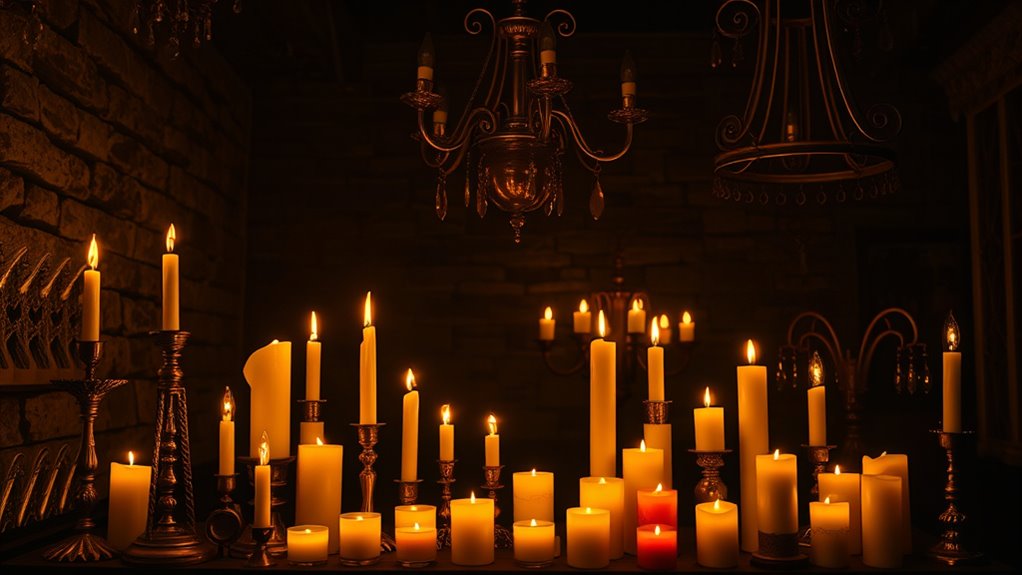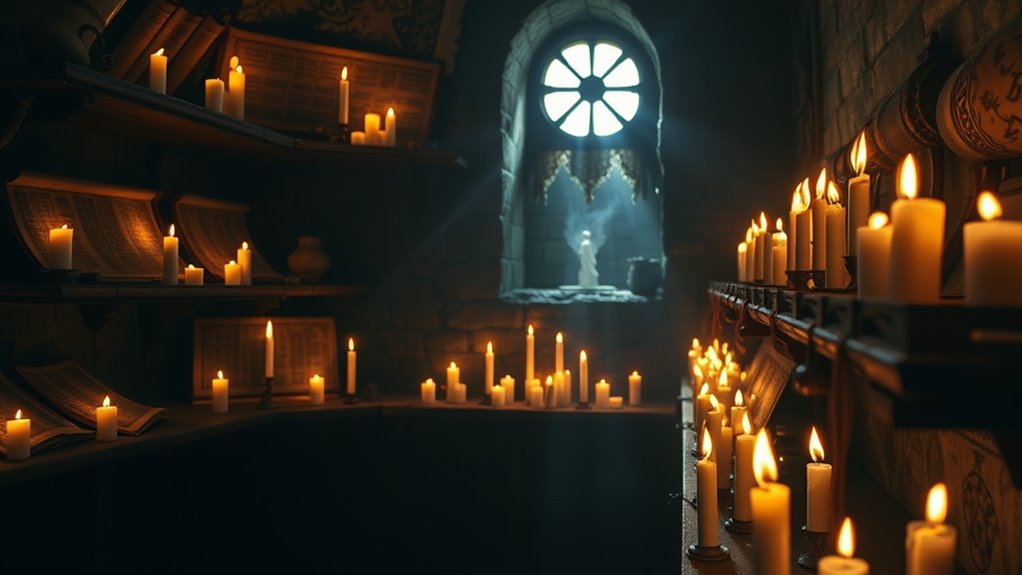For over 4,000 years, candlelight has transformed human life, evolving from primitive fire-starting tools to symbols of hope, spirituality, and comfort. Early civilizations used tools like torches and simple candles made from fats and waxes. The invention of paraffin wax and better wicks in the 19th century made candles more reliable and affordable. Despite electric lights, candles still carry deep symbolic meaning—explore further to discover how their journey shaped your world today.
Key Takeaways
- Candles originated over 4,000 years ago using primitive materials like animal fats and waxes for better lighting.
- Early candles faced issues like smoke, short burn times, and inconsistent flames, prompting continuous innovations.
- The 19th-century invention of paraffin wax made candles cheaper, cleaner, and suitable for mass production.
- Despite the rise of electric lighting, candles retained cultural, religious, and aesthetic significance.
- Candlelight symbolizes hope, spirituality, and intimacy, reflecting centuries of human desire for better illumination.

Have you ever wondered how candlelight has shaped human history? It’s a fascinating journey that spans thousands of years, beginning with simple tools and evolving into the sophisticated lighting we enjoy today. The story starts with the wax evolution, where early civilizations experimented with different materials to create a steady, reliable source of light. Initially, humans used torches made from wood or animal fat, but these were often smoky and inefficient. Over time, they discovered that certain fats and waxes could produce cleaner, longer-lasting flames. Beeswax, in particular, became a prized material because it burned bright and clean, making it a luxury item reserved for the wealthy or religious ceremonies. As civilizations advanced, so did their lighting innovations. They developed the earliest candles by dipping rolled strips of cloth or reeds into wax or tallow, creating a more portable and manageable light source. These primitive candles, however, still had limitations—smoke, inconsistent flames, and a short burn time.
As the centuries passed, the wax evolution continued, with innovations aimed at improving candle performance. The introduction of stearic acid, derived from fats, made candles harder and more durable. Meanwhile, the development of paraffin wax in the 19th century marked a significant turning point. Paraffin was cheaper, burned cleaner, and could be mass-produced, making candles more accessible to everyday people. This was a true lighting breakthrough, transforming candle-making from an artisanal craft into an industrial process. It also spurred further advancements, such as the use of wicks made from cotton or other fibers that improved flame stability. By the late 1800s, electric lighting was beginning to emerge, but candles remained essential for emergency lighting, religious rituals, and ambiance, maintaining their historical importance. Additionally, the development of light-emitting technology has gradually replaced candles in many applications, but their symbolic significance persists.
Throughout history, candlelight has served more than just illumination; it’s been a symbol of hope, spirituality, and intimacy. The ongoing improvements in wax and wick technology have allowed candles to evolve from simple fire-starting tools into crafted objects of art and comfort. Today, even with modern lighting, candles continue to evoke a sense of warmth and tradition, reminding us of their rich history. Their journey from primitive beginnings to modern lighting innovations demonstrates how human ingenuity has continually refined and redefined the way we light our world. Candlelight’s story is a testament to our desire for better, safer, and more meaningful ways to illuminate life’s moments.
Frequently Asked Questions
How Did Candle Technology Evolve Over Millennia?
You see, candle technology evolved as people improved wax composition and lighting techniques. Early candles used animal fats, but over time, you switched to beeswax and paraffin for cleaner burns. You also developed better wicks and molds, which enhanced brightness and consistency. These innovations allowed you to create more efficient, longer-lasting candles, making lighting more reliable and adaptable for diverse cultural and practical needs throughout history.
What Cultural Significance Did Candles Hold in Ancient Societies?
Imagine a flickering flame revealing secrets in ancient darkness. Candles held profound cultural significance, shaping religious rituals and serving as social symbols. They marked sacred moments, connected communities, and symbolized enlightenment or hope. Their glow transcended mere illumination, embodying spiritual presence and social cohesion. In ancient societies, candles weren’t just practical; they were powerful symbols that linked the spiritual to the everyday, igniting hope and unity in times of darkness.
Which Materials Were Used in Early Candle Manufacturing?
You learn that early candle manufacturing mainly used materials like tallow and beeswax for wax composition, which provided a steady, reliable flame. For wick materials, early candles often used fibers like cotton or linen, which drew melted wax upward effectively. These materials helped create functional candles that lit homes and rituals, shaping cultural practices across ancient societies.
How Did Candles Influence Historical Events and Daily Life?
You see, candles played a essential role in shaping history and daily life through their symbolism and practical uses. They symbolized hope, spirituality, and remembrance, influencing rituals and ceremonies. In modern times, candles still serve for relaxation, ambiance, and celebrations. Their presence connects past and present, showing how simple tools can carry deep meaning and practical importance, making them timeless symbols in our culture.
What Are Some Unique Candle Traditions Worldwide?
Your curiosity sparks a flame brighter than history itself. Around the world, candlelit rituals and global candle customs create powerful connections—like the Chinese Lantern Festival’s glowing lanterns symbolizing hope, or Diwali’s vibrant diyas representing spiritual victory. These traditions honor ancestors, celebrate festivals, and mark milestones. Each unique candle ritual reveals a culture’s soul, proving that lighting a candle can be more meaningful than a thousand words.
Conclusion
As you light a candle today, remember you’re igniting a flame that has whispered through 4,000 years of history. Each flicker symbolizes hope, guidance, and resilience—like a tiny lighthouse in the darkness. Your candle becomes a bridge, connecting ancient shadows to modern moments. In its glow, time pauses, and you become part of a timeless story—a shining affirmation of human ingenuity and the enduring power of light to illuminate our way forward.









